

John Jodauga's illustrations, words, and spirit were part of the NHRA for 50 years
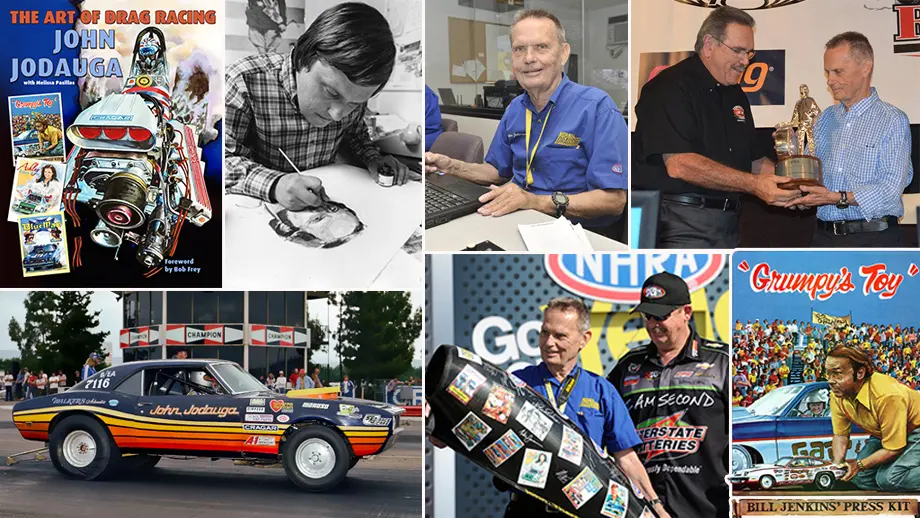
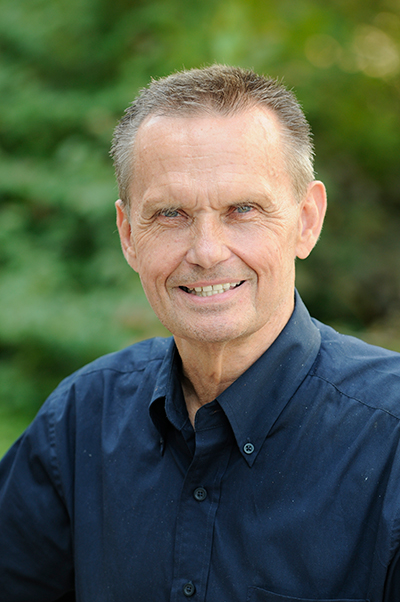
John Jodauga, the talented motorsport artist, longtime former member of the NHRA National Dragster staff, and the man with the most mispronounced last name in motorsports, left us last week, passing away May 11 at age 77 after a brief illness.
Jodauga (pronounced Joe-Dew-Gah, by the way) gained a level of drag racing illustrating immortality with a series of creative press kit covers for the likes of Bill “Grumpy” Jenkins, Gary Gabelich, John Buttera, and more traditional artwork for the likes of Don Nicholson, Bob Glidden, Don Prudhomme, Raymond Beadle, Paul Blevins, Wally Booth, Gapp & Rousch, and others. If you sense a common thread among those in Pro Stock, you’re right. He loved the class from its founding in 1970 until the day he passed.
Jodauga first worked for National Dragster both as an art director and staff writer from 1969 to 1978, again in 1984-85, and then worked under me again on the editorial staff for 20 years, from 1993-2013, before retiring. He was our go-to guy for all things Pro Stock and leaves behind a lasting legacy of amazing drawings and friendships with just about everyone he ever met.
Especially in Pro Stock.
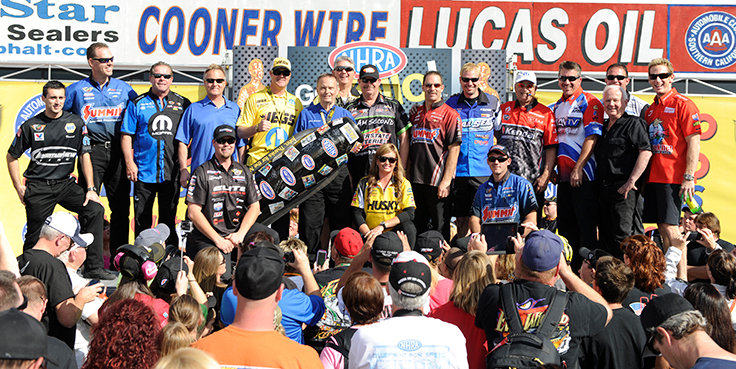
When he retired at the end of the 2013 season, every Pro Stock driver entered at that year’s NHRA World Finals joined a surprised Jodagua on stage during the pre-race ceremony, where he was presented with an authentic Pro Stock hood scoop autographed by all of them to thank him for his tireless work in reporting and promoting the class.
With an NHRA career that spanned 43 years over three separate stints — a staff record — broken up by his time running his own advertising business (where he continued being in our lives as a perpetually late deliverer of his advertising artwork), there’s a lot to tell about John Jodauga.
He was rock solid and a very valued member of the staff for all those years. As his boss, sometime traveling companion, and later treasured friend, John could drive you nuts as easily as he could make you smile. He was a huge Los Angeles Dodgers fan (he even attended a fantasy camp in 1983, the story about which he never got tired of telling; we all heard it dozens of times), was a diehard fan of the quirky television show Twin Peaks and, later, Game of Thrones, loved building plastic models, and never got tired of entertaining us with quick-sketch cartoons about the staff of which we never grew tired.
Although he became world-famous as a drag racing artist, John could draw anything. He drew portraits of people’s kids and pets and even their hobbies. Several years ago, I was writing a Dragster Insider column about how 1970s West Coast drag racing stars used to ride motorcycles together off-road, leading to many misadventures. I didn’t have a lot of original photos, so I described a couple of the misadventures to John, who quickly whipped up some funny, column-ready pieces of art.
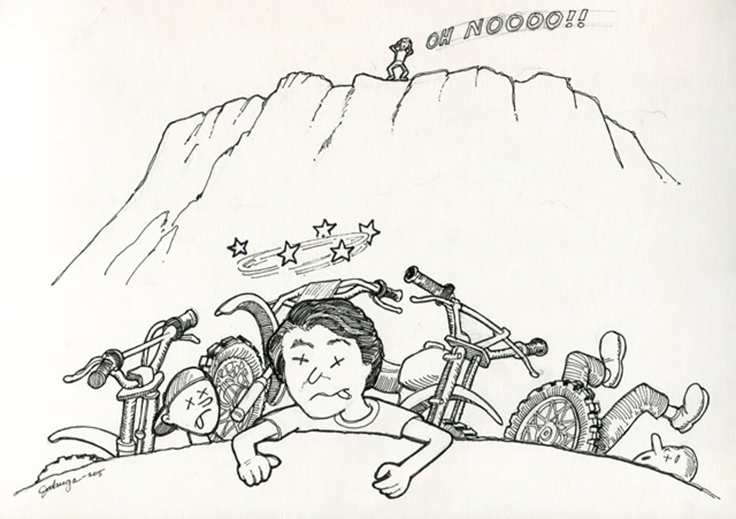
Here's ‘70s Funny Car star Sush Matsubara after coming around a blind turn and over a cliff. Funny stuff.
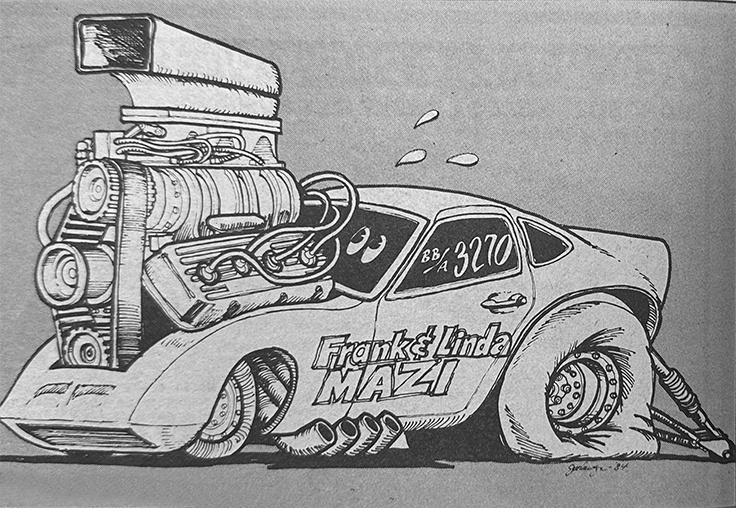
John also helped illustrate "Altered States," my unforgettable 1984 trial by fire in the Mazi family supercharger Opel with this lead drawing of me definitely sweating out my time in the short-wheelbase, high-horsepower rollerskate of a race car. [Reprinted here]
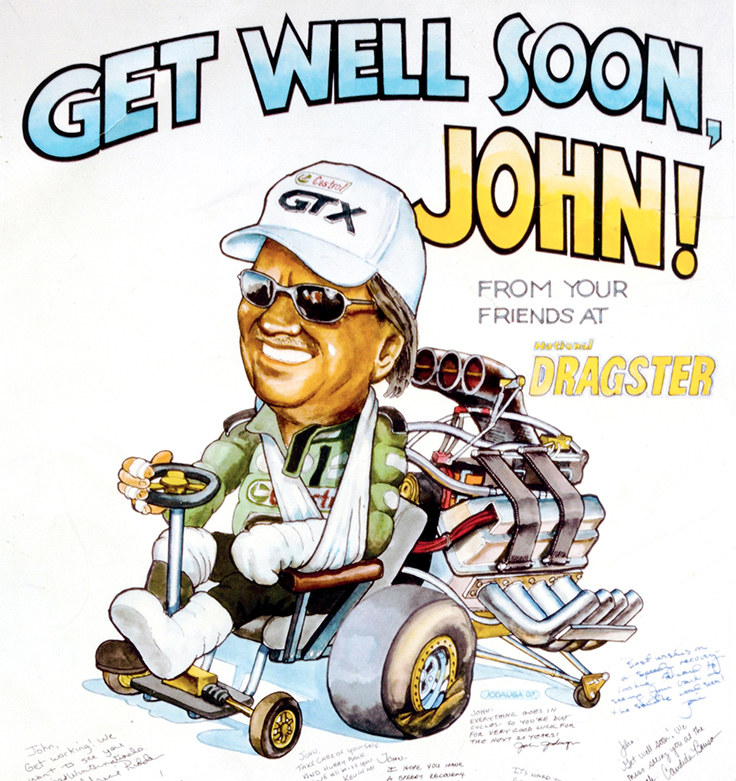
And when John Force was injured in that horrible 2007 crash in Dallas, the Dragster staff wanted to send him a get-well card. Jodaguga, naturally, obliged.
John was as talented (and not nearly as late) a writer as he was an artist. People liked John — maybe because he had so many interests and was interested in more about them than just drag racing — and would open up to him and share great stories and information.
Just ask Pro Stock great Jason Line.

"I always enjoyed talking with John," he told us. "He was passionate about the sport. He loved it, and he loved the people in it. He was fun to be around, because he didn't just love the racing, he loved the whole crazy, unique world that is drag racing. For me, he was always one of the people I was comfortable talking about things with. I think our viewpoints were similar on a lot of things. I wish I would have known him in his younger days, but I enjoyed the time we did have together."

And when Pro Stock star Wally Booth was inducted into the International Drag Racing Hall of Fame in 2013, it was Jodauga, of course, whom he asked to help induct him. John wrote a wonderful introduction that showcased all of Booth's accomplishments, then greeted his old friend on the stage with a handshake and a hug.
Jodauga was an interesting bridge for the staff from his earliest days back when it was manual typewriters in the office and hot type at the printer to the computer age, and he did it for as long as he could before hanging it up.
The stories of those early days are epic, including when Joduga and the late, great Bill Crites were assigned to drive National Dragster issues from North Hollywood, Calif., headquarters to Indy for the NHRA U.S. Nationals.

"We were told to take turns driving without stopping off at a motel, and initially that didn’t bother us because there were lots of wide-open spaces on the old Route 66 in which we could make up for lost time," Jodauga told me for a 2009 column after the passing of our loony pal. "But to our disappointment, we discovered that the truck was equipped with an engine governor that restricted the speeds to 55 mph, which meant that the trip would take about 40 hours. Crites came up with the idea of attempting to dismantle the governor by intentionally backfiring the engine, and although the ploy failed at its original goal, we both got pretty good at producing a big bang.
"As dusk was approaching at the end of the second day, we spotted a band of genuine Woodstock-era hippies thumbing for a ride while standing beneath the overpass. I shut off the engine to prepare for the backfire, and as we slowly pulled over, the hippies, who were thinking we were stopping to provide them a ride, smiled and flashed us the peace sign as they eagerly approached the truck. But when the ignition was turned back on, a huge ball of fire, enhanced by the growing darkness and the reverberating roar from being beneath the overpass, emerged from beneath the truck, and the kindly expressions on their faces were quickly replaced by eye-bulging, mouth-gaping sheer terror as they truly felt that they were facing Armageddon."
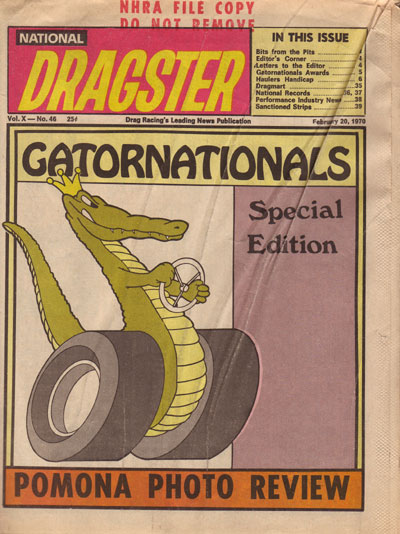
And, didja know that it was John Jodauga who created the iconic Gatornationals logo of a grinning gator burning rubber? Yep, that was him, and he did it in 1970, when the race was first introduced as part of the expanded "Super Season."
"Because there were no corporate event sponsors at the time, Wally wanted the logo to simply tie in with the name of the event, much in the same manner that the famous snowflake was a part of the original Winternationals logo for years," he told me a few years ago. "So, I came up with a rough sketch of an alligator with a pair of drag racing slicks in place of his rear legs, and put a steering wheel in his hands. After getting Wally’s initial approval, I drew up the logo in the cartoon style that I had developed over the years as a big fan of Walt Disney comic books, and it was used as the cover for the Gatornationals Souvenir Edition of National Dragster. I enjoyed the fact that the logo soon appeared on the starting line A-board and was also used on T-shirts to promote the event."
It’s no surprise that Jodauga became a Pro Stock fan. At his first drag race, the 1964 Winternationals, he admits he was impressed with the power and thunder of the Top Fuel cars, but what really caught his attention were the Super Stock and A/Factory Experimental cars that used carbureted, gasoline-burning, 427-cid engines to record elapsed times well into the 11-second zone.
Six years later, he was standing on the starting line at the 1970 Winternationals as a newly hired National Dragster reporter, covering the debut of Pro Stock.
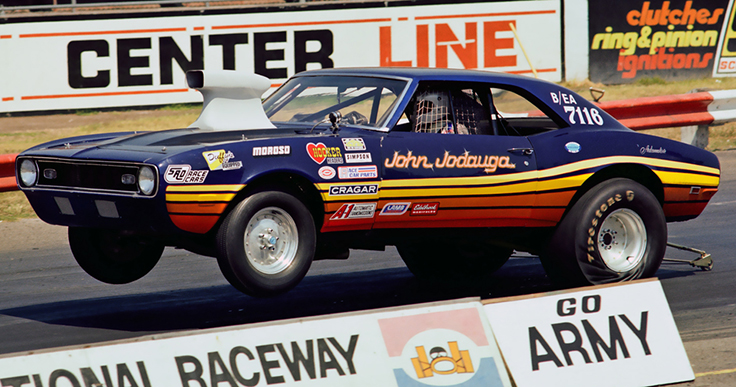
John took his love of doorcars even further, fielding a ’68 Camaro in Super Stock and Econo Altered (photo credit: Auto Imagery) and later even attended Roy Hill’s Pro Stock school (where part of taskmaster Hill’s advice to him, famously, was “Jodauga, get yer head out of yer ass.”), but it was his artistic skills that got him noticed and for which he’ll probably always be best remembered. Jodauga was a graduate of the prestigious Art Center College of Design in Pasadena, Calif., but he had plenty of famous drag racing people to thank for his first big break.
Because I have easy access to so many of his Dragster articles, I’ll let J.J. tell the story, as he did as part of a 2005 staff-written column called "The Write Lane."
“The first such person is my original drag racing hero, 'Dyno Don' Nicholson, the legendary pioneer of the Super Stock, Funny Car, and Pro Stock ranks. During the summer of 1966, like most drag racing fans, I eagerly awaited my weekly treks to the local speed shop to pick up the latest issue of National Dragster to read about Nicholson’s latest match race results and those of the other stars on the match race circuit.

“That fall, I began doing freelance artwork for Drag Racing magazine, and one of my first assignments was to do a pencil portrait of Nicholson for the publication’s Driver of the Year Perma-Plaque award. Nicholson was the John Force of his era as he not only dominated the scene with a win-loss ratio in excess of 90 percent, but he also found a way to give something back to the fans in return for their support.
“After our first meeting, Nicholson allowed me to hang out at his winter shop in Irwindale, Calif., and then he overwhelmed me when he invited me to travel with him and his crew to attend the AHRA Winternationals in Phoenix the following January. That was quite a rush for a kid who, just months earlier, had only associated with his heroes through reading about them in the drag racing tabloids, and the upcoming trip became more exciting when Drag Racing’s editors suggested that I write and illustrate a feature article on the venture.
“Nicholson gave me more than enough material to work with when he won the event by defeating his then archrival Eddie Schartman in the final. It was a thrill that I’ll always remember, and though I didn’t know it yet, it would lead me to meet another legendary drag racing figure.
“After the Nicholson piece was published, a subsequent issue of Drag Racing featured a letter from NHRA President Wally Parks, who had written to compliment my artwork. I responded to Parks’ letter by requesting a portfolio showing with NHRA. As a result of that meeting, I was given cover art assignments for several NHRA national event programs and eventually was hired at National Dragster in 1969. After having progressed from reading about my drag racing heroes to meeting them, I found myself in the process of actually writing about them as a reporter for my favorite drag racing publication. Parks had not only welcomed me into the NHRA family, but he had also generously granted me the flexibility to continue my freelance artwork and writing ambitions.
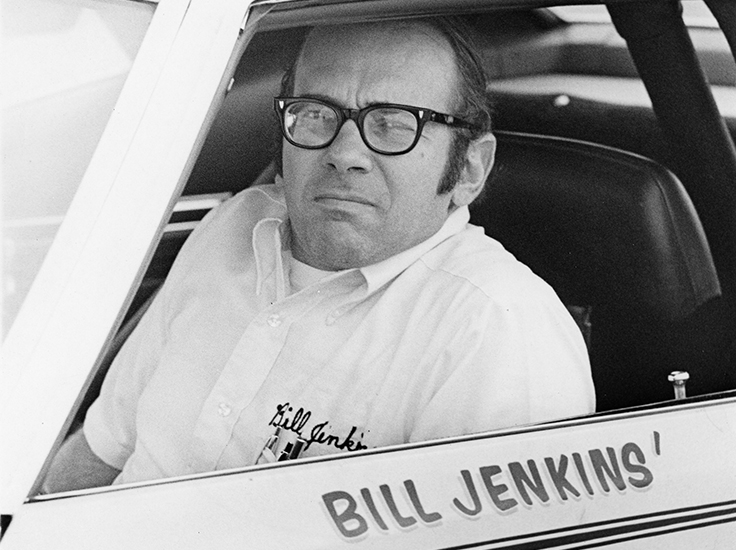
“It was that freelance work that led me to the third inspirational person on my journey thus far, my first public relations client, Bill 'Grumpy' Jenkins. His reputation as a no-nonsense individual who suffered fools lightly was well known, and for the first two years or so, I worked with him in equal parts awe and intimidation.
“But the gruff exterior was just that — a shell that concealed a thoughtful and open-minded personality, and when I worked up the nerve to suggest that we try something different from the traditional face and race car illustrations for his press kit covers, he was willing to give it a try.
“The first of these illustrations was a radical departure from the ones that came before it. Unlike previous covers which perpetuated Jenkins’ 'Grumpy' persona, this one showed Jenkins’ head on a superhero-type body for a cover with the title ‘Super Grump Comix’ following his record-breaking season with his small-block Vega Pro Stocker in 1972.
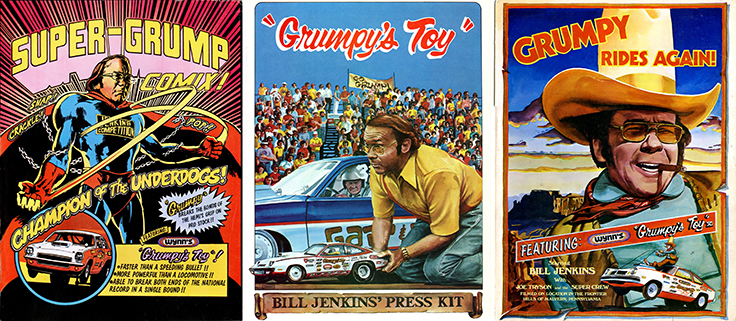
“In another illustration, to capitalize on Jenkins’ ‘Grumpy’s Toy’ fame, I took pictures of him on his hands and knees, staging a toy car on the starting line beams. And when Jenkins posed for photos while wearing a cowboy outfit I rented from a Hollywood, Calif., costume store, (for a press kit entitled ‘Grumpy Rides Again’) he chose to do so out in the open pit area at Ontario Motor Speedway during one of the Supernationals events, hamming it up in front of the huge throng of fans gathered for the session. Seeing the smile on Jenkins’ face during this photo session was very gratifying in that he not only had taken the advice of this young journalist but that he was also enjoying himself as well.”
You can see all of these (bigger and better) in this photo gallery that I created featuring many of John's major works.
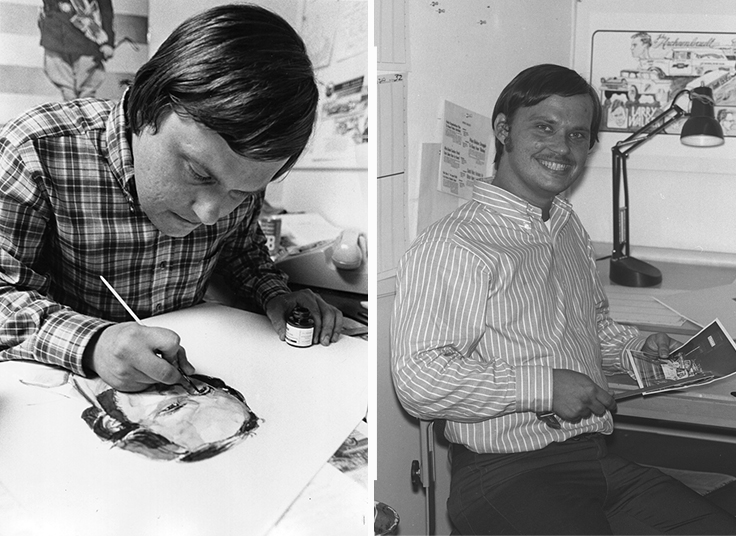
John’s editorial illustrations have appeared over the years on the pages of Hot Rod, Car Craft, Motor Trend, and, of course, National Dragster. His artwork, along with his words, filled National Dragster in the 1970s. His black and white portraits of that week’s ProFile feature subject ran on pretty much every cover in the late 1970s.
In late 2011, Jeff Mellem, our current Art Director for Special Projects, and former ND copy editor Melissa Pasillas helped J.J. compile his works for a wonderful 90-page collection of his artwork over the years, complete with stories about each one. You can still find The Art of Drag Racing on Amazon and other online booksellers. It’s a great piece filled with tons of amazing artwork and, best of all, J.J.’s recollections of the pieces.

John also authored an encyclopedic book on his favorite subject for us in 2009. The History of NHRA Pro Stock covered the class’ formative years before it became a national event class, all the way up through, at the time, 2009. Jodauga later revised it for us up through 2019 in advance of Pro Stock’s 50th anniversary in 2020. Because he was so hands-on with the class, both from his mechanical interest and first-person interactions with many of the stars of the sport, he was able to provide incredibly detailed information about not just the mechanical advancements and experimentation, but also the principals themselves. Again, this book is still readily available on Amazon com and other places. If you’re a Pro Stock fan, check it out.
Over the years with ND, John probably wrote hundreds of stories. He was the primary writer (along with the late Chris Martin) for a popular 1980s-1990s feature called “Where Are They Now?” in which he’d track down great personalities from drag racing’s earlier days, recap their careers, and bring everyone up to speed on what they were up to. In many ways, it was this column long before this column existed, and many times I’ve used the first-hand recounts and quotes from those subjects as background for my columns here. I have to admire their gumption in tracking down people without the internet or the computerized driver index that we now have.
As I‘ve mentioned, and you will read in an amazing collection of memories from John’s friends and former colleagues, John was nothing if not a good sport about his own shortcomings, whether that meant tardiness in turning in his advertising work, his fondness for (and inability to clean up after) snacks, and, well, his golf game.

In 2007, the National Dragster staff published a series of articles we referred to as “teach me,” where we’d hang out with Pro racers and try to have them teach us their favorite hobbies. I went trap shooting with Robert Hight, Candida Benson took calf-roping lessons from Eric Medlen, and Bruce Dillashaw went flying with Doug Herbert. Jodauga decided he wanted to play golf with Bob Vandergriff Jr., who, in addition to being a national-event-winning Top Fuel driver, was a multi-sport high school star and an impressive plus-one handicap in golf.
Jodauga, whose previous experience in golf probably consisted of putting through windmills, traveled to Alpharetta, Ga., to tee off with Vandergriff at the Golf Club of Georgia. He was so bad at it that he flew home, took private lessons, then flew back to complete the story. He did not let his pride get in the way of a good story.
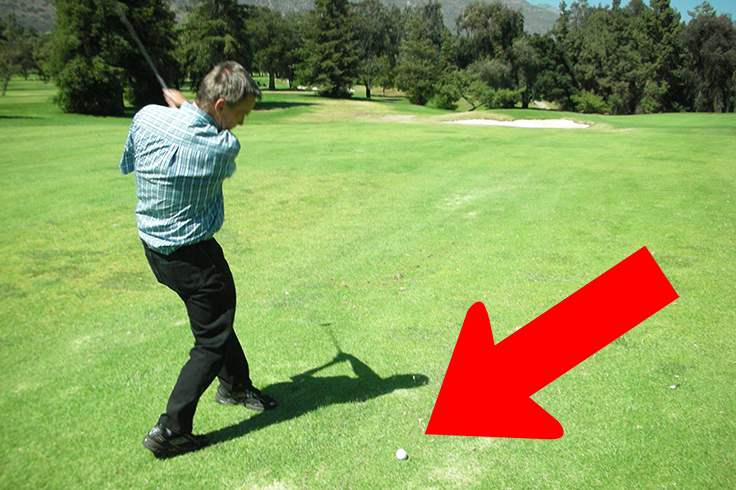
Like a schoolboy eager to show his parents what he has just learned at school, I jump out of the cart to take my first swing. … Instead of hearing the expected “thwack” that comes with solid contact, I hear an embarrassing “whoosh” as the club completely misses the ball. Without the anticipated contact to impede my swing, my muscle memory betrays me, and the follow-through is so exaggerated that I nearly fall over backward.

John worked and traveled with us through the 2013 season when he was well into his 60s. His body just couldn’t take it anymore. He had started distance running in 2004, and almost finished the L.A. Marathon on his first attempt. This photo is funny in that instead of listing his last name on the name tag, he chose "Jugawater," which comes from a funny story, retold to me recently by his then-editor at ND, Bill Holland: "John was constantly faced with people mispronouncing his last name. He once lamented that when the Arrowhead water man came to his studio and knocked on the door. He asked 'who’s there?' The water guy replied, 'jug of water.' Without hesitation, J.J.emphatically said, “No, no. It’s pronounced Joe-Dew-Gah.”
Anyway, despite his running and being in what I’d call good shape, all the years took their toll. He just couldn’t travel anymore and asked me about a stay-at-home job in the office, but back then there weren’t any job descriptions for that. It broke my heart.
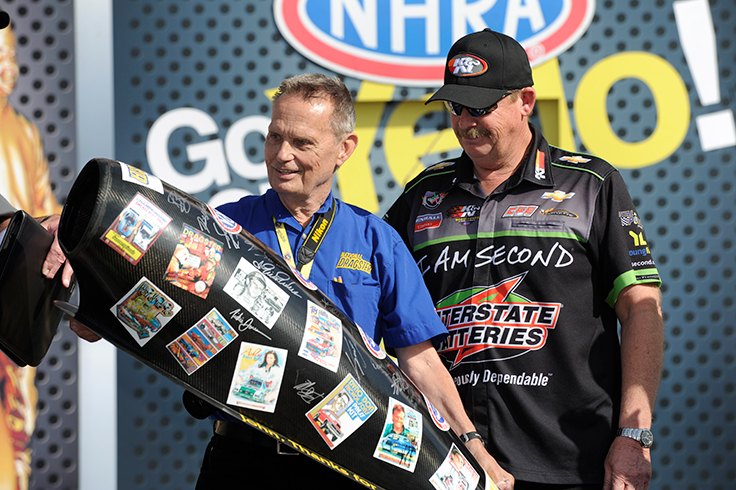
The sendoff from the Pro Stock drivers at the 2013 season finale gave up all lumps in our throats. Current Photo Editor Jerry Foss had told V. Gaines about John’s impending retirement. Gaines donated a hood scoop upon which were plastered small reproductions of his artwork. It was signed by everyone in attendance. I don’t know that I’d ever seen J.J. without words, but this may have been one of those times. He had no idea it was coming until he was hauled up onto the stage.
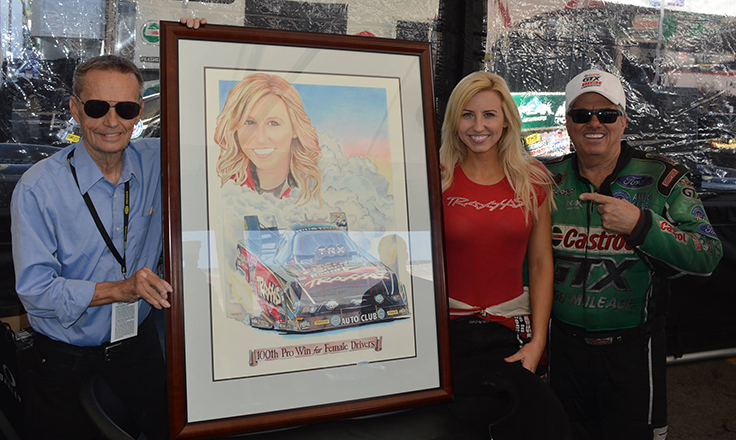
John went on to have a renaissance in his artwork, taking commissions from drivers like John Force, who asked J.J. for portraits of his daughters, and also memorializing great moments in the sport’s history like Warren Johnson’s 200-mph Pro Stock pass, Kenny Bernstein’s 300-mph Top Fuel run, and more.

As I mentioned before, he could draw anything for anyone that asked. Check out this 2011 painting he did for then-Pro Stock racer Steve Kent, who also liked to go on safari in Africa.
Jodauga had a number of medical setbacks over the last few years — back surgery, a stroke, and, most painfully for him, arthritis in his hands that pretty much ended his ability to draw and paint — but he always wanted to keep contributing. His fingers and brain certainly still worked well.
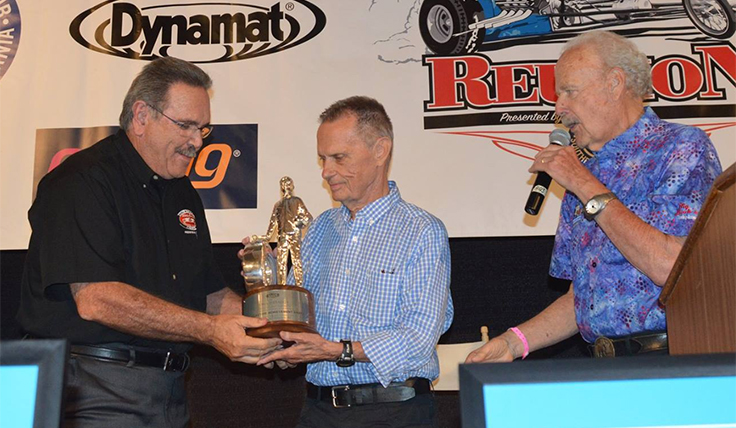
Jodauga was honored for his lifetime of work at the 2015 NHRA California Hot Rod Reunion, which was very appropriate as for years, even after he retired from NHRA, he, along with then-NHRA Museum curator Greg Sharp, would help us put together the souvenir program for the Hot Rod Reunions, tracking down and interviewing the honorees and collecting photos for their profiles. It was tough work, but they always got it done. I always felt good paying John out of our freelance budget, helping him to pay the bills and keeping his name alive.
After Sharp retired, Jodauga tackled them alone, and it was for this year’s Wally Parks NHRA Nostalgia Nationals that I gave him what would be his final assignment, a Top 10 list of grand marshal Don Garlits’ greatest moments. I shared a bunch of my research with him and, with the help of NHRA historian Bob Frey, we settled on the 10.
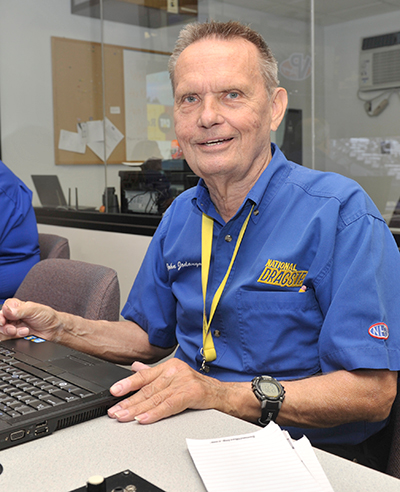
John didn’t finish the assignment before falling ill in April with pneumonia. He was hospitalized for about a month, and my wonderful daughter, Kim, a healthcare advocate, knowing how much I cared about John, helped him pro bono to navigate the insurance nightmare, and he always talked about how he still had a story to finish and didn’t want to miss his deadline.
His condition only worsened over the month. A foursome of current and former Dragster staff went to see him on what would be his second-to-last day. We told him how much we loved him, reminisced about old times, and told him not to worry about the Garlits feature. I also told him, even though we knew it wasn’t going to happen, that I expected him to be back at work for the Bakersfield, Calif., program in October. And then he was gone, just a few days before Mother’s Day, and was reunited to share the day with his loving mom.
I was glad we got to share that time with him and let him know how much he meant to us all.
We were able to get his uncompleted Garlits manuscript off his computer, and I will finish it for him, proud to give him — and share with him — a final byline: By John Jodauga and Phil Burgess.
There are so many other people who knew and loved John, and who shared their memories with me, that it deserves its own space, which you can find in this accompanying column. I hope you’ll read it and come to know and love the John that we all knew and treasured.
Thank you, John Jodauga, for all you gave us and all you meant to us. We’ll miss you, pal.
Phil Burgess can be reached at pburgess@nhra.com
Hundreds of more articles like this can be found in the DRAGSTER INSIDER COLUMN ARCHIVE
Or try the Random Dragster Insider story generator



















































